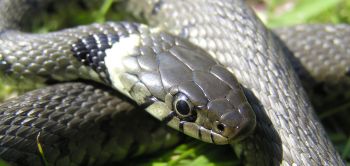Broadcast: News items
Reptiles and amphibians equally at risk of extinction
By: Alison Field
Last updated: Tuesday, 20 October 2009

Photo: Jules Howard/ARC
The threat of extinction facing amphibians around the world may be just as severe for reptiles, say scientists from the University of Sussex and UK wildlife charity Amphibian and Reptile Conservation.
Writing in the journal Diversity, they argue that future research should be more equally balanced so that investment mirrors the risk to each group.
A report by the International Union for Conservation of Nature (IUCN) in 2004 revealed that one-third of all amphibian species worldwide were threatened with extinction.
A global reptile assessment is as yet incomplete but already research indicates that a similar risk of extinction may also be facing reptiles such as snakes, lizards, turtles and crocodiles.
"It is increasingly clear that amphibians are not alone in facing a major biodiversity crisis," says lead author Professor Trevor Beebee of the University of Sussex. "Other groups of 'cold-blooded' vertebrates, notably reptiles and freshwater fishes, are in the same boat."
The review also cites evidence that, even though both groups of species may be facing a similar threat of extinction, recent scientific research into the decline of amphibian numbers far outweighs research into the decline of reptiles.
In the new study, the authors searched scientific publications from 2005-09 under the theme of 'biodiversity and conservation', comparing the numbers that contained amphibian-related search terms (such as "frogs" or "toads") with those containing reptile-related search terms (such as "lizards" or "snakes").
The results showed that published scientific papers covering amphibian declines outnumbered papers covering reptile declines by four to one (153 papers to 42 respectively), even though there are substantially fewer species of amphibians than of reptiles in the world (6,347 and 8,734 species respectively).
Similar findings emerged when looking solely at published studies relating to native amphibians and reptiles in the UK. From 2005-09 there were 69 'biodiversity and conservation' papers on the seven native British amphibians, compared to just 20 papers on the six native terrestrial reptile species.
"Evidently there has been a significant bias towards study of declines in the amphibians," say the paper's authors. "The question arises as to whether the bias in favour of amphibian decline research is justified on the basis of risk."
Though amphibians and reptiles differ in their anatomy and life-histories, the causes of declines and extinctions are similar for both groups of species. They include habitat loss, invasive wildlife species and disease, pollution, climate change and the impact of roads. Disturbance and persecution (particularly of snakes) are an added cause of concern to reptiles.
To reduce the risk of extinction, the authors suggest that research should focus on the effects of habitat management and other methods of practical conservation.

